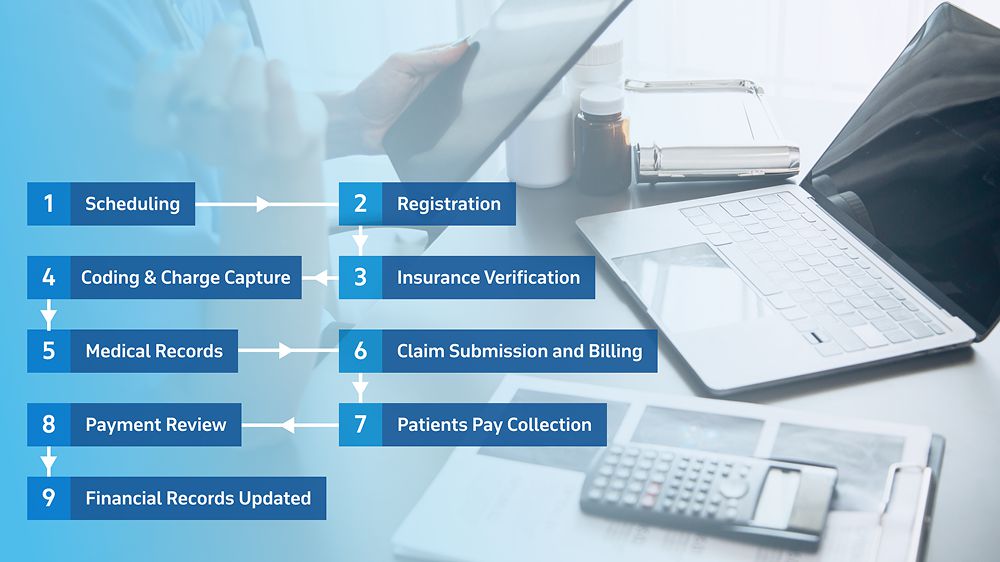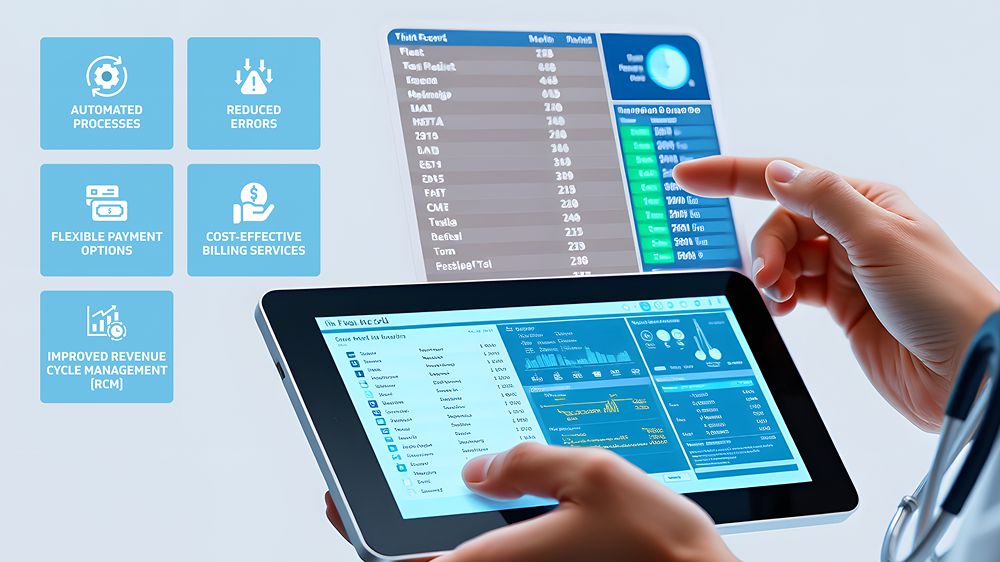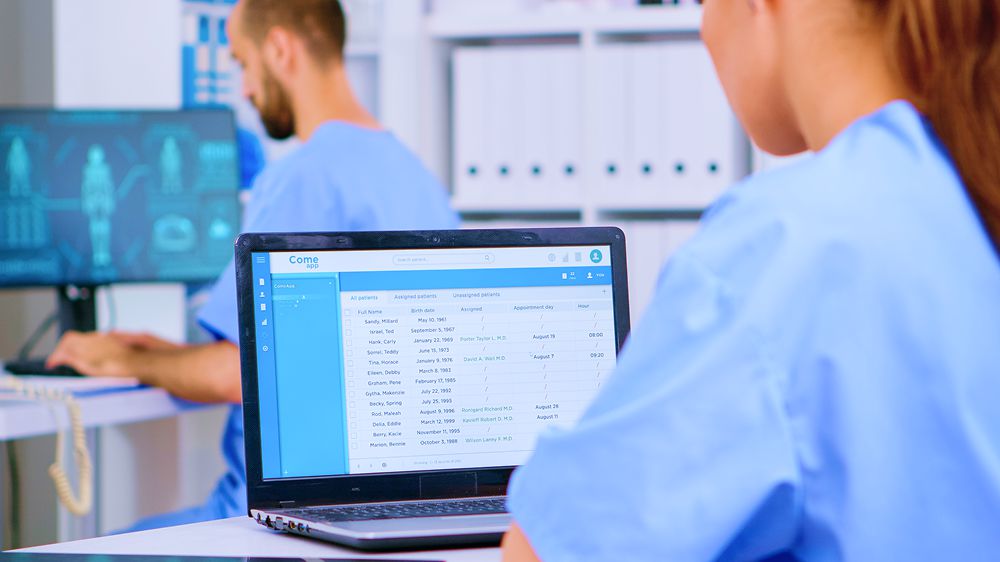Healthcare providers charge patients for the medical services they receive, including diagnoses, treatments, prescriptions, and administrative tasks. The final bill must reflect every service provided. Developing robust medical billing software can significantly streamline hospital and clinical invoicing workflows.
A well-designed healthcare billing system minimizes errors that often frustrate patients and providers. Research shows that around 80% of medical bills in the U.S. contain mistakes that result in overbilling, underbilling, and financial discrepancies.
Healthcare institutions can effectively address these issues by integrating advanced billing software. However, the billing process is inherently complex and requires technical, clinical, and regulatory expertise. Ready to learn more about simplifying your billing workflow? Dive into our blog for expert insights and practical solutions!

What is Medical Billing Software?
Medical billing software is an all-in-one solution designed to streamline billing and revenue cycle management for healthcare providers. It automates tasks such as submitting claims to insurance companies, monitoring claim statuses, processing payments, and managing patient invoices. Additionally, the software ensures accurate application of medical codes (ICD, CPT, HCPCS) for services provided, minimizing human error and enhancing the precision of claims.

Types of Medical Billing Software
There are three types of medical billing systems that healthcare practitioners can apply.
1. Open Billing System
Open billing systems integrate with Electronic Health Records (EHR), giving healthcare professionals transparent access to patient information. Data sharing across departments becomes seamless, enhancing collaboration and improving patient care.
While this approach boosts efficiency, it may introduce security risks if proper safeguards aren’t in place. Smaller practices might also find implementation costs and training requirements challenging. Despite these considerations, the system’s ability to streamline workflows makes it valuable for large healthcare facilities.
2. Closed Billing System
A closed billing system limits access to patient information to designated healthcare practitioners, ensuring strict control over data visibility. Operating like digitalized paper charts, it keeps information compartmentalized and prevents sharing between physicians or departments.
Enhanced data security is a key advantage, as restricted access reduces the risk of unauthorized use. However, the inability to share data can impede collaboration and create inefficiencies, particularly in larger healthcare facilities. Smaller practices with simpler workflows may find this system more suitable.
3. Isolated Billing System
An isolated billing system is designed exclusively for patient use. It allows individuals to track their visits and billing details independently. Healthcare providers, including physicians and institutions, have no access to the data managed within this system, keeping it entirely patient-controlled.
The system empowers patients by offering complete transparency and control over their billing information. However, the lack of integration with healthcare providers can lead to discrepancies or communication gaps, making it less practical for coordinated care settings. This system best suits individuals seeking autonomy over healthcare billing without involving providers in data management.
How Does the Medical Billing Software Work?
Simply put, medical billing software simplifies and optimizes the billing cycle for healthcare providers. Below is an overview of how this system ensures efficiency and accuracy in managing patient and financial data.

1. Scheduling
The medical billing process starts when patients book appointments for consultations or treatments. Upon confirmation, the system logs the appointment as the foundation for tracking all related billing activities. The software recording the scheduled visit ensures that every service, procedure, or charge is accurately associated with the patient’s visit, creating a clear and organized billing workflow.
2. Registration
At the hospital or clinic reception, patients provide essential personal and insurance details, which get entered into the medical billing software to create or update their profile. Accurate registration is crucial, ensuring that all subsequent billing steps, such as insurance verification and claim submissions, are processed smoothly. A well-maintained patient profile helps eliminate discrepancies, speeds up the billing cycle, and ensures that the patient’s information is readily available for future visits or services.
3. Insurance Verification
The medical billing software verifies the patient’s insurance eligibility and coverage details, ensuring that the insurer covers the treatments provided. By conducting this verification early in the process, healthcare providers can avoid potential disputes or unpaid claims later on. This step reassures both patients and providers, confirming that the financial aspects of the treatment are in order before proceeding with services.
4. Coding and Charge Capture
Medical staff document the diagnoses, treatments, and services provided during a patient’s visit, translating these details into standardized medical codes, such as ICD for diagnoses and CPT for procedures. Accurate coding ensures all services are properly billed and claims are submitted correctly. Proper charge capture minimizes errors, facilitates smooth reimbursement from insurers, and ensures that healthcare providers are compensated for their services.
5. Medical Records
The patient’s medical history is updated with new details from each visit, including diagnoses and treatments provided. Updates ensure continuity of care and maintain an accurate record for billing purposes. Comprehensive medical records play a critical role in audits and legal compliance, helping verify that all services rendered are correctly documented and meet regulatory standards.
6. Claim Submission and Billing
A superbill is generated to summarize all the coded services provided during the visit. The billing software submits the bill directly to the insurance provider or issues it to the patient for payment. Claim submission plays a critical role in the billing process. Errors in this step can lead to delays or rejections, which can significantly impact revenue and cause delays in reimbursements.
7. Patients Pay Collection
For claims the insurance company approves, the remaining balance, such as copayments or uncovered costs is billed directly to the patient. The billing software tracks all payments made and identifies any outstanding dues, ensuring that the patient’s financial responsibility is addressed correctly and the healthcare provider receives prompt payment.
8. Payment Review
The insurance company reviews the submitted claim to determine whether it will be approved, adjusted, or denied based on the patient’s coverage and policy terms. The billing software updates the payment status accordingly and flags any claim rejections or necessary corrections, helping to ensure that the claim is processed correctly in the following steps.
9. Financial Records Updated
Once claims are approved and payments are made, the billing system updates the financial records to reflect the approved claims, patient payments, and any remaining balances. This ensures the financial overview is accurate and current, supporting precise financial reporting and analysis for the healthcare provider.
Benefits of Medical Billing Software
Custom medical billing software offers a range of benefits for medical practices and billing services. Here are seven major advantages of designing and adopting a tailored solution.

1. Automated Processes
Medical billing software streamlines and automates bill claims and reimbursement procedures, significantly improving operational efficiency. It handles follow-up claims by sending timely alerts and notifications, ensuring smooth payment workflows without delays. The software also automatically verifies patient eligibility, reducing friction in the payment and reimbursement process. With automated tasks, healthcare staff can focus more on providing quality care, as administrative distractions are minimized, allowing for a more efficient and patient-centered approach to healthcare delivery.
2. Reduced Errors
Medical billing software uses advanced algorithms to ensure error-free patient claims before submission. Integrating data from medical reports and procedures streamlines coding practices, leading to more accurate reimbursements. Incorporating AI unifies and automates coding and charting, further enhancing data entry efficiency. With secure, uniform coding integrated into patient databases, the software reduces claim denials, improving revenue and operational flow for healthcare providers.
3. Flexible Payment Options
Medical billing software integrates with multiple payment processors, providing various settlement options that improve accessibility and affordability for patients. Mobile-friendly patient portals with intuitive interfaces enable easy payment processing, allowing patients to manage their bills conveniently from any device. These flexible payment solutions enhance the overall patient experience while ensuring efficient payment collection for healthcare providers.
4. Cost-Effective Billing Services
Custom billing software reduces the need for additional staff by improving efficiency and minimizing errors, leading to lower operational costs. It enhances profitability by integrating with clearinghouses and insurers, accelerating reimbursement. Unlike off-the-shelf solutions, custom software offers long-term savings and requires fewer costly modifications. Additionally, it provides valuable insights into essential features, assisting healthcare providers in making informed decisions when evaluating existing billing solutions.
5. Improved Revenue Cycle Management (RCM)
Medical billing software effectively tracks and manages the entire billing cycle, from claims submission to reimbursement. It includes tools to monitor claims in real-time, allowing healthcare providers to address issues and prevent denials proactively. By improving the speed and accuracy of revenue collection, the software plays a crucial role in enhancing healthcare organizations’ financial sustainability.
Key Features to Look For in a Medical Billing Software
When developing a minimum viable product (MVP) for medical billing software, it’s important to focus on just a few essential features, even though many solutions offer an extensive range of tools to automate invoicing:
1. Billing Processes Automation
Medical billing software automates the entire billing workflow, reducing the manual workload for medical staff and freeing them to focus on patient care. By seamlessly transferring captured information between departments, from patient registration to claim reimbursement, there is no need for manual intervention, improving efficiency across the organization.
The system also allows for rule-based billing by setting predefined billing rules. Medical codes and charges are automatically applied to registered patients, ensuring consistency, reducing human error, and enhancing the billing process’s accuracy and speed.
2. Integration with Electronic Health Records (EHR)
Integration with EHR consolidates patient data from multiple healthcare systems, using standards like HL7 to enhance patient care management and streamline workflow efficiency. This seamless data transfer between systems ensures all relevant information is available for accurate billing and improved coordination across departments.
Basically, integration helps reduce billing errors by ensuring that patient data is transferred accurately between systems, eliminating the need for manual data entry. This reduces the risk of mistakes leading to payment delays or claim rejections, supporting smoother revenue cycle management.
3. Customization Options
The software incorporates best UI/UX practices with user-friendly descriptions designed to meet the needs of its users. By allowing for customization, medical staff can tailor the system to fit the operational requirements of the practice better, improving overall usability and adoption rates.
Customizable billing workflows help align the software with specific organizational needs, ensuring the system supports unique business processes. This flexibility leads to greater user satisfaction and a more effective, streamlined billing experience for healthcare providers.
4. Reporting and Analytics Capabilities
Medical billing software provides powerful reporting tools that allow healthcare providers to track patient payment trends, revenue growth, expenses, and overall profitability. These insights enable providers to make informed decisions regarding financial strategies and optimize billing practices for better outcomes.
The analytics capabilities empower healthcare and financial teams with actionable data, fostering transparency and improving decision-making. With detailed reports, providers can identify opportunities for improvement and address any financial gaps, ensuring efficient revenue cycle management.
How to Develop Medical Billing Software?
Developing custom medical billing software requires meticulous planning and execution to address the unique requirements of healthcare providers.

This detailed 6-step guide outlines the essential stages involved in creating a tailored solution that optimizes billing workflows and improves accuracy:
1. User Needs Analysis
Developing medical billing software begins with a comprehensive user needs analysis. Surveys and interviews with healthcare providers, such as doctors, nurses, administrators, and billing staff, provide insights into their operational challenges and billing requirements. To streamline the revenue cycle, common pain points must be identified. Claim denials, delayed reimbursements, and data entry errors must be addressed. Collaborating with key stakeholders ensures the software addresses diverse professional needs while prioritizing features based on their impact, which helps establish a focused development roadmap.
2. Core Features Research
Researching core features is essential to creating effective medical billing software. User-focused functionalities, such as patient information management, appointment scheduling, and user-friendly billing interfaces, enhance operational efficiency. Admin-side capabilities, including advanced reporting tools, claim submission and tracking, and robust HIPAA-compliant security measures, are also incorporated to meet compliance and administrative needs.
3. Building an MVP (Minimal Viable Product)
An MVP focuses on delivering core functionalities to address healthcare providers’ most pressing billing needs. Select user groups are engaged to test the MVP, providing usability, performance, and interface design feedback. This feedback is used to refine the solution and validate its viability before scaling the software further.

4. Development
The development process involves assembling a skilled team with expertise in medical billing software and healthcare compliance. Various models can be adopted, including building an in-house team for greater control, outsourcing to external teams for cost and time efficiency, or partnering with a technology provider to oversee the development process.

5. Testing and Quality Assurance
Rigorous testing ensures the software is free of bugs, usability issues, and performance bottlenecks. Functional, regression, and user acceptance testing validate that the solution meets operational requirements. Complex scenarios, such as insurance claims, billing codes, and data integration, are tested to confirm the software’s reliability.
6. Launch and Maintenance
The launch phase involves comprehensive end-user training to enable a smooth transition from manual to digital billing systems. A gradual introduction minimizes disruption and maintains operational continuity. Regular updates ensure the software remains secure, compliant with healthcare regulations, and capable of adapting to new feature requirements. Ongoing performance monitoring and user feedback help maintain the software’s relevance and efficiency.
How KMS Healthcare Can Support Developing a Medical Billing Software
Medical billing software development drives progress in healthcare by simplifying complex billing tasks and supporting regulatory compliance. The need for reliable, secure, and efficient solutions grows as healthcare evolves, transforming how providers manage operations and deliver care.
At KMS Healthcare, we specialize in delivering tailored solutions to meet the unique challenges of healthcare providers:
- HealthTech Development Teams: Assemble skilled development teams to bring your medical billing software projects to fruition, delivering innovative and scalable solutions customized to your specific requirements.
- Custom Healthcare Software Solutions: Design and develop bespoke software that enhances billing processes, data management, and operational workflows.
- Compliance & Security: Secure medical billing software that adheres to industry regulations and maintains the highest data integrity, privacy, and patient safety standards.
Contact us today for a consultation and discover how we can streamline your medical billing software development process!